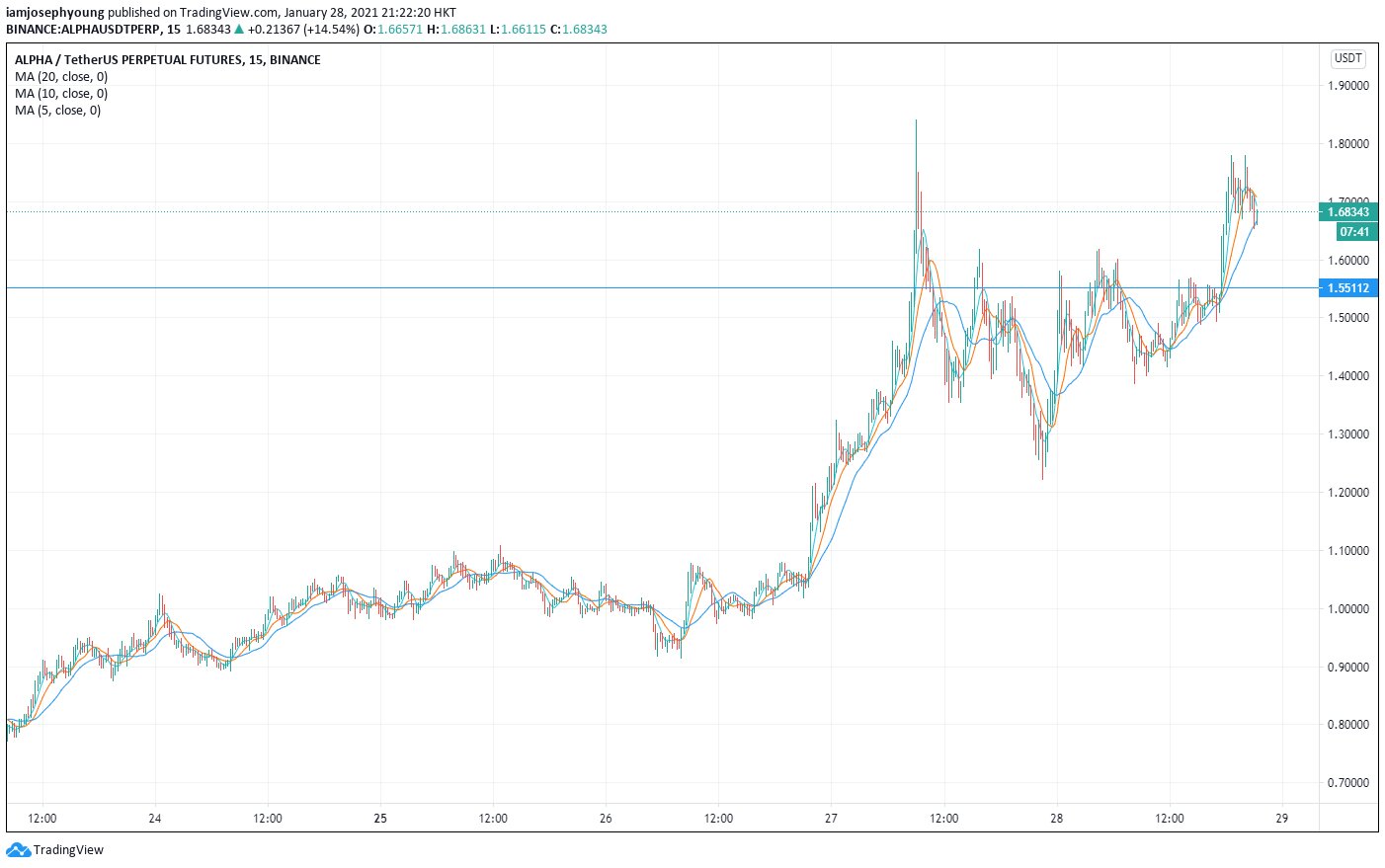Introduction
In the world of cryptocurrency, investors are constantly seeking ways to maximize their returns. One term that frequently arises in discussions about crypto investing is “alpha”. Alpha refers to the measure of an investment’s performance compared to a benchmark or market index. It represents the excess returns that an investor can earn above the expected market return.
Understanding and harnessing alpha in crypto can be a game-changer for investors. It holds the key to outperforming the market and generating significant profits. However, the concept of alpha can be complex and multifaceted, with various factors contributing to its calculation and interpretation.
In this article, we will delve into the world of alpha in crypto and explore its significance. We will discuss the factors that determine alpha, the different types of alpha, and strategies that can be employed to generate alpha in the cryptocurrency market. Additionally, we will highlight the risks associated with pursuing alpha and the importance of having a well-defined risk management strategy.
Whether you are an experienced crypto investor or a novice looking to enter the market, understanding alpha is crucial for achieving financial success. By grasping the nuances of alpha and implementing effective strategies, you can potentially unlock greater returns in the highly volatile and lucrative crypto market.
Understanding Alpha in Crypto
When it comes to investing in cryptocurrencies, alpha represents the excess returns generated by an investment above the expected market return. It is a measure of an investor’s skill in identifying profitable opportunities and outperforming the overall market.
Alpha can be seen as a way to gauge an investor’s ability to beat the consensus and achieve above-average returns. In the crypto world, where volatility is high and market conditions can change rapidly, understanding and generating alpha is crucial for achieving success.
To calculate alpha, one needs to compare the return of a specific investment with a benchmark or market index. The benchmark serves as a reference point, representing the average performance of the market. If an investment consistently outperforms the benchmark, it indicates positive alpha, implying that the investor has skillfully generated excess returns.
While alpha is often associated with outperforming the overall market, it is important to note that it can also be negative. Negative alpha suggests that the investment has underperformed the market, indicating that the investor has not been able to generate excess returns and may need to rethink their strategy.
Alpha is a crucial metric for investors as it provides insights into the effectiveness of their investment decisions. It allows them to assess their performance relative to the broader market and identify areas where improvements can be made.
In the crypto market, achieving alpha can be particularly challenging due to its unique characteristics. Unlike traditional financial markets, cryptocurrencies are highly volatile and influenced by numerous factors such as regulatory changes, technological advancements, and market sentiment. As a result, generating alpha requires a deep understanding of the cryptocurrency ecosystem and the ability to identify undervalued assets or market trends.
Furthermore, it is important to note that alpha is not solely dependent on the market’s direction. Even during downward trends, skilled investors can uncover opportunities to generate positive alpha by strategically shorting certain cryptocurrencies or taking advantage of market inefficiencies.
In the next sections, we will explore the factors that determine alpha in crypto and the different types of alpha that investors can pursue in their quest to outperform the market.
What Determines Alpha in Crypto?
Alpha in crypto is influenced by various factors that contribute to the overall performance of an investment. Understanding these determinants can help investors make informed decisions and increase their chances of generating alpha.
1. Market Knowledge: Deep knowledge and understanding of the cryptocurrency market is essential for identifying opportunities and making informed investment decisions. Keeping tabs on market trends, news, and updates allows investors to stay ahead of the curve and uncover potential alpha-generating assets.
2. Fundamental Analysis: Conducting thorough fundamental analysis is crucial in evaluating the intrinsic value and potential growth of a cryptocurrency. This includes assessing factors such as technology, team, partnerships, and market demand. By identifying undervalued assets with strong fundamentals, investors can position themselves for alpha generation.
3. Technical Analysis: Technical analysis involves studying price patterns, trends, and indicators to predict future price movements. By analyzing charts and utilizing technical tools, investors can identify entry and exit points, enabling them to capitalize on short-term market inefficiencies and generate alpha.
4. Risk Management: Effective risk management is essential for generating alpha in crypto. It involves setting proper stop-loss levels, diversifying investments, and managing position sizes. By actively managing risks, investors can protect their capital and minimize potential losses, ensuring a more stable and consistent alpha generation.
5. Timing: Timing is a critical determinant of alpha in the crypto market. Identifying market cycles and entering or exiting positions at optimal times can significantly impact investment performance. This requires a combination of technical analysis, market sentiment analysis, and experience.
6. Innovation and Adaptability: The cryptocurrency market is constantly evolving, with new technologies and projects emerging regularly. Keeping pace with these developments and being open to adopting new strategies and investment approaches can help investors stay ahead in generating alpha.
7. Network and Collaboration: Engaging with fellow investors, participating in crypto communities, and collaborating with experts can provide valuable insights and ideas. Networking helps investors access a wider range of information, perspectives, and alpha-generating opportunities.
It is important to note that while these factors contribute to alpha generation, there is no guaranteed formula for success in the crypto market. The unique and unpredictable nature of cryptocurrencies means that investors must continually adapt and refine their strategies to stay competitive and capture alpha.
In the next sections, we will explore the different types of alpha that investors can pursue and the strategies they can employ to generate alpha in the cryptocurrency market.
Types of Alpha in Crypto
Generating alpha in the cryptocurrency market can take various forms. Understanding the different types of alpha can help investors identify the most suitable strategies to pursue and maximize their returns.
1. Directional Alpha: This type of alpha is based on correctly predicting the direction of the cryptocurrency market. Investors who can accurately anticipate market trends and take appropriate long or short positions can generate alpha. This can be achieved through technical analysis, fundamental analysis, or a combination of both.
2. Arbitrage Alpha: Arbitrage opportunities arise when there are price discrepancies for the same cryptocurrency across different exchanges or trading pairs. By exploiting these price differences, investors can buy low and sell high, generating alpha without taking on significant market risk. However, arbitrage opportunities in the crypto market are often short-lived and require quick execution.
3. Market Making Alpha: Market makers provide liquidity to the market by placing buy and sell orders on both sides of the order book. They earn alpha by capturing the spread between buy and sell prices. Market making requires sophisticated algorithms and a deep understanding of order book dynamics, as well as sufficient capital to manage risks associated with price fluctuations.
4. Quantitative Alpha: Quantitative strategies involve using mathematical models and algorithms to identify patterns, correlations, and anomalies in the cryptocurrency market. These strategies aim to exploit inefficiencies and generate alpha based on statistical analysis. Quantitative alpha can be achieved through high-frequency trading, statistical arbitrage, or quantitative trend following.
5. Venture Capital Alpha: Investing in early-stage cryptocurrency projects and startups can provide significant alpha if the investments are successful. Venture capital alpha is generated by identifying promising projects with transformative potential and participating in their early funding rounds. However, this type of alpha comes with high risks, as many startups fail to deliver their intended outcomes.
6. Social Media Sentiment Alpha: This type of alpha involves leveraging social media platforms and sentiment analysis tools to gauge market sentiment and make investment decisions accordingly. By monitoring discussions and sentiment around specific cryptocurrencies, investors can identify emerging trends and sentiment-driven price movements.
It’s worth noting that these types of alpha are not mutually exclusive, and investors can combine different strategies to enhance their overall alpha generation. The key is to identify the approach that aligns with one’s risk appetite, investment horizon, and skill set.
In the next section, we will explore strategies that can be employed to generate alpha in the cryptocurrency market.
Strategies to Generate Alpha in Crypto
Generating alpha in the cryptocurrency market requires a strategic approach and a deep understanding of market dynamics. Here are some strategies that investors can employ to increase their chances of generating alpha:
1. Trend Following: This strategy involves identifying and following trends in the crypto market. By analyzing price patterns and utilizing technical indicators, investors can enter positions aligned with the prevailing market trend. Trend following strategies aim to capitalize on momentum and ride the wave of price movements to generate alpha.
2. Contrarian Investing: Contrarian investors take the opposite approach of the market consensus. They identify assets that are undervalued or oversold and go against the prevailing sentiment. This strategy seeks to profit from market sentiment swings and potential reversals, generating alpha when the market starts to shift in the opposite direction.
3. Event-Driven Trading: Event-driven trading focuses on identifying and capitalizing on price movements triggered by specific events, such as product launches, partnerships, regulatory announcements, or major market developments. By staying informed and reacting swiftly to market events, investors can take advantage of short-term opportunities to generate alpha.
4. Arbitrage Trading: As mentioned earlier, arbitrage involves exploiting price discrepancies across different exchanges or trading platforms. Investors can take advantage of these temporary price differences by buying low on one exchange and selling high on another. Automated trading bots and sophisticated algorithms are often used to execute trades quickly and capture arbitrage opportunities.
5. ICO Investing: Initial Coin Offerings (ICOs) provide opportunities for early-stage investment in new cryptocurrency projects. Conducting thorough due diligence and identifying projects with strong potential can lead to significant alpha generation if the project succeeds. However, ICO investing comes with high risks, as many projects fail to deliver their promised outcomes.
6. Diversification: Diversifying a crypto portfolio across multiple cryptocurrencies and tokens can help mitigate risks and increase the likelihood of generating alpha. By spreading investments across different asset classes, industry sectors, and market segments, investors can take advantage of various opportunities while minimizing the impact of any individual investment’s performance.
7. Staking and Yield Farming: Staking involves holding and “staking” cryptocurrencies to support the network’s operations and earn rewards in the form of additional tokens. Yield farming, on the other hand, involves providing liquidity to decentralized finance (DeFi) protocols in exchange for rewards. Both strategies allow investors to earn passive income and generate alpha through token rewards and interest.
It is important to note that these strategies come with their own risks and require careful consideration and proper risk management. Investors should conduct thorough research, stay informed, and continually adapt their strategies to the evolving market conditions to maximize alpha generation.
In the following section, we will address the risks associated with pursuing alpha in the cryptocurrency market.
The Risks of Pursuing Alpha in Crypto
Pursuing alpha in the cryptocurrency market can be highly rewarding, but it is not without its risks. It is important for investors to be aware of and manage these risks effectively. Here are some of the key risks associated with pursuing alpha in crypto:
1. Market Volatility: The cryptocurrency market is known for its extreme volatility. Prices can experience rapid and significant fluctuations, which can lead to substantial gains or losses. The high volatility increases the risk of generating negative alpha, especially if investments are not timed or executed correctly.
2. Regulatory Uncertainty: The regulatory landscape surrounding cryptocurrencies is constantly evolving, and regulations can vary significantly across different jurisdictions. Changes in regulations or government interventions can have a significant impact on the crypto market and investments. Investors need to stay informed about regulatory developments to mitigate potential risks and ensure compliance.
3. Technology and Security Risks: Cryptocurrencies are built on decentralized technologies, which can be vulnerable to technical glitches, hacking attempts, or security breaches. The loss or theft of digital assets can lead to substantial financial losses. Investors must take adequate measures to secure their holdings, such as using secure wallets and following best security practices.
4. Liquidity Risks: Some cryptocurrencies may have limited liquidity, especially new or less popular ones. This can make it challenging to buy or sell large amounts of a particular asset without significantly impacting its price. Illiquid markets can pose risks such as slippage and difficulties in executing trades, potentially impacting alpha generation.
5. Operational Risks: Engaging with crypto exchanges, wallets, or other service providers introduces operational risks. Exchanges can experience technical issues, suffer from hacks, or even shut down unexpectedly. Investors must choose trustworthy and reputable platforms while also implementing robust security measures to mitigate operational risks.
6. Emotional Bias and Speculative Nature: The crypto market is highly speculative, and investor decisions can be influenced by emotions, market hype, or fear of missing out (FOMO). Acting on emotional impulses rather than sound analysis can lead to irrational investment decisions and increased risks. It is important to maintain a disciplined and objective approach when pursuing alpha in crypto.
7. Lack of Regulation and Market Manipulation: The absence of comprehensive regulations in the crypto market leaves room for potential market manipulation, fraudulent activities, and pump-and-dump schemes. Investors should be cautious of suspicious projects, excessive hype, and unrealistic promises that could lead to significant financial losses.
Managing these risks requires a combination of proper risk management practices, thorough due diligence, continuous monitoring of the market, and staying informed about regulatory developments. By adopting a cautious and disciplined approach, investors can mitigate potential risks and increase their chances of generating alpha in the crypto market.
In the final section, we will summarize the key points discussed and highlight the importance of balance and informed decision-making in pursuing alpha in crypto.
Conclusion
Alpha in the cryptocurrency market represents the excess returns that investors can achieve by outperforming the broader market. Understanding and generating alpha in crypto requires a combination of market knowledge, analysis, and strategic decision-making.
Investors can pursue various strategies to generate alpha, such as trend following, contrarian investing, arbitrage trading, and participating in ICOs. Each strategy comes with its own risks, and it is important for investors to implement proper risk management practices to mitigate potential losses.
Factors such as market knowledge, fundamental and technical analysis, timing, risk management, innovation, and collaboration contribute to alpha generation in crypto. However, the crypto market’s unique characteristics, including high volatility, regulatory uncertainties, and technology risks, must also be taken into consideration.
To pursue alpha successfully, investors need to balance their appetite for risk with a disciplined and informed approach. Thorough research, staying informed about regulatory developments, and continuously adapting strategies to changing market conditions are key elements of generating alpha in crypto.
While alpha presents opportunities for investors to maximize returns, it is essential to remember that there are no guaranteed outcomes in the crypto market. Prudent risk management, diversification, and maintaining a long-term perspective can help investors navigate the risks and increase their chances of generating alpha over time.
By understanding the nuances of alpha in crypto and implementing effective strategies, investors can potentially unlock greater returns and leverage the opportunities presented by the ever-evolving cryptocurrency market.

























